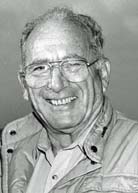 William Aaron Nierenberg (February 13, 1919 – September 10, 2000) was an American physicist who worked on the Manhattan Project and was director of the Scripps Institution of Oceanography from 1965 through 1986.
William Aaron Nierenberg (February 13, 1919 – September 10, 2000) was an American physicist who worked on the Manhattan Project and was director of the Scripps Institution of Oceanography from 1965 through 1986.
Nierenberg attended the City University of New York, where he won a scholarship to spend his junior year of university abroad, in France at the University of Paris. He entered graduate school at Columbia University in 1939, but spent the war years from 1942 seconded to the Manhattan Project, working on isotope separation, before returning to Columbia to complete his PhD.
n 1948 Nierenberg took up his first academic staff position, as Assistant Professor of Physics at the University of Michigan. From 1950 to 1965 he was Associate and then Professor of Physics at the University of California, Berkeley, where he had a very large and productive low energy nuclear physics laboratory, graduating 40 PhD’s during this time and publishing about 100 papers. During that period he took a one-year leave to serve as the director of the Columbia University Hudson Laboratory. Later, he oversaw the design and construction of the “new” physics building at Berkeley. Much later (1960–1962) he took leave once again as Assistant Secretary General of the North Atlantic Treaty Organization (NATO) in charge of scientific affairs, where he oversaw many international studies on physics and advanced defense technologies.
In 1965 Nierenberg was asked to run the Scripps Institution of Oceanography (SIO). As SIO’s longest serving director, he quadrupled the funding for the institution and developed a fleet of five modern research vessels. In 1965, he was also elected to the National Academy of Sciences and to the Council of the National Academy of Sciences (NAS) in 1979. He was also elected to the National Academy of Engineering, and the National Academy of Arts and Sciences.
He served on a large number of prestigious committees, primarily after he returned from NATO. In 1971 he was appointed chairman of the National Academy of Sciences National Advisory Committee on Oceans and Atmosphere and served on this committee until 1977. Nierenberg served on various panels of the President's Science Advisory Committee. He was a member of the National Science Board from 1972 to 1978 and was appointed for another term from November 1982 to May 1988.
Nierenberg was a consultant to the National Security Agency, and served on many military-related panels. In 1976 he was appointed one of two senior consultants to the then newly formed White House Office of Science and Technology Policy (OSTP). He was a member of the National Aeronautics and Space Administration’s (NASA) Advisory Council from 1978 to 1982 and served as its first chairman. He was Chairman of the OSTP Acid Rain Peer Review Panel, whose report "Acid Rain" was published in 1984. The report encouraged the administration to curb acid rain emissions.
By October 1980, during the Carter presidency, an Act of Congress was passed requesting the National Academy of Science to review what was known about climate change. Nierenberg was appointed by the Academy to chair the committee to produce this report on the risks of global warming, which two previous reports for the Carter administration had highlighted as a potential major problem.
Nierenberg subsequently became a co-founder of the George C. Marshall Institute, and a critic of some of the scientific conclusions of various research papers when being one was rather unpopular with some. A building on the campus of the Scripps Institution of Oceanography is named for him and the Nierenberg Prize for Science in the Public Interest has been started. The recipients have been E. O. Wilson, Walter Conkite, Jane Lubchenco, David Attenborough, Jane Goodall, Craig Venter, Gordon Moore, James E. Hansen and Richard Dawkins.
In addition to the Procter Prize, Nierenberg was awarded The Delmer S. Fahrney Medal (1987).